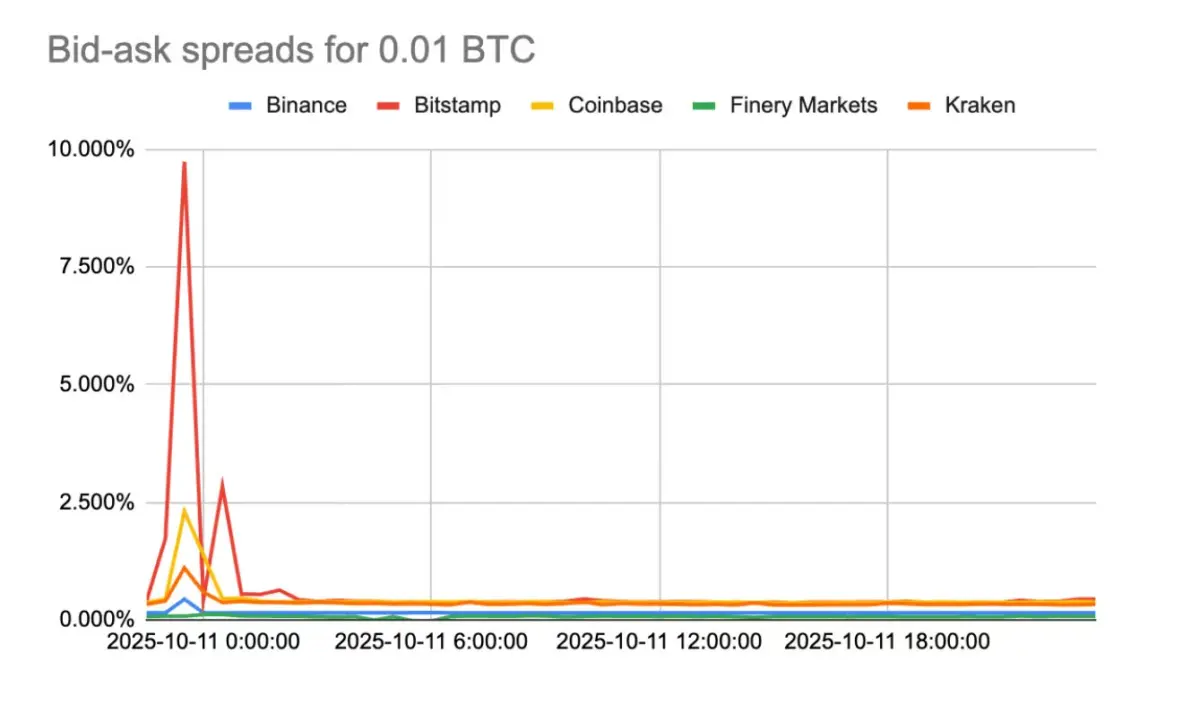OTC desks acted as the market’s shock absorbers during the October liquidation, enabling large trades off-exchange and preventing visible order-book stress from cascading across centralized venues. Finery Markets’ data show private-room volumes and tighter spreads limited systemic contagion and reduced forced selling on public exchanges.
-
OTC liquidity absorbed large sell flows, limiting spillover to public order books.
-
Finery Markets and Coinglass data show aggressive liquidations wiped out over $20 billion in leveraged positions, while OTC rooms saw a surge in private trading.
-
Bid-ask spreads: Bitstamp peaked near 9.8%, Binance ~0.6%, Finery OTC stayed below 0.4%; private BTC/USDT and ETH/USDT volumes rose 107% week-on-week.
OTC desks stabilized markets during the October liquidation, limiting contagion and preserving liquidity across major pairs. Read COINOTAG’s concise analysis and recommended next steps.
What are OTC desks and how did they prevent market contagion?
OTC desks are private trading venues that facilitate large, bilateral trades off public order books. During the October sell-off, OTC desks allowed institutional and large retail participants to transact without revealing size to public order books, which helped dampen panic-driven price swings and contained systemic contagion.
How did Finery Markets quantify OTC impact?
Finery Markets reported a sharp divergence between private-room activity and centralized exchange flows. Over the October 10–12 window, private BTC/USDT and ETH/USDT trading volumes on Finery’s platform jumped 107% week-on-week, while the same pairs on centralized exchanges saw a 48% increase. Finery also recorded bid-ask spreads below 0.4% on its OTC platform throughout the stress period, compared with brief spikes of up to 9.8% on Bitstamp and around 0.6% on Binance. These figures indicate that large counterparties preferred private execution to minimize market impact, according to Finery Markets.
Finery Markets described OTC infrastructure as “a firewall against systemic contagion,” noting the key structural difference: visible public order books vs private, negotiated fills. The firm emphasized that private execution reduced the need for displayed liquidity to absorb sizable sell orders, thereby preventing order-book depletion on major exchanges.
Market shock and liquidation metrics
Macro headlines, including a statement by U.S. leadership introducing tariffs and export controls, triggered a rapid risk-off reaction that fed into crypto markets. Coinglass data referenced by market observers recorded more than $20 billion in leveraged positions liquidated within 24 hours. Reports indicate over 1.6 million traders were liquidated and more than $7 billion in positions were unwound in a single hour at the height of the event.
Bitcoin, which had reached a weekly high above $124,000 on some venues, fell more than 12% and printed near $113,000 on Bitstamp by early Saturday. Derivatives flows shifted as traders and institutions sought protection: Coinglass derivatives monitoring showed increased activity in protective contracts on Bitcoin around $95,000 and Ethereum near $3,600.
Where liquidity drained and which instruments were affected?
Volatility propagated from core assets into synthetics and staking derivatives. Finery Markets observed selling pressure impacting stable-asset synthetics such as Ethena’s USDe, Wrapped Beacon Ether (wBETH), and Binance Staked SOL (BNSOL). USDe briefly traded as low as $0.65 on Binance during intense sell flows, though it generally maintained its peg on Curve, Fluid, and Bybit pools. Decentralized finance pools and some staking derivatives saw meaningful liquidity depletion as participants rebalanced or exited positions rapidly.
 Finery vs centralized exchanges’ bid-ask spreads. Source: Finery
Finery vs centralized exchanges’ bid-ask spreads. Source: FineryCharting from Finery Markets that tracked the liquidation episode showed centralized exchange spreads expanding and periods of localized stress on order books, while the OTC spread profile remained comparatively flat. This pattern suggests large participants used dark liquidity venues to execute without precipitating further visible price pressure.
Leverage dynamics and trader outcomes
High leverage magnified losses. As Finery Markets summarized: “A 10% BTC drop on a 10x position becomes a 100% wipeout.” Traders using double-digit leverage and no stop-loss protections experienced rapid account liquidations when prices breached maintenance margins. CoinGlass data flagged that liquidation volumes during this event surpassed notable prior crashes, increasing the severity of the short-term sell-off.
Institutional responses were mixed. Some institutions, identified in market reporting as long-term holders, bought the dip—one public holder increased Bitcoin holdings to a reported 640,250 coins. Meanwhile, institutional inflows into BTC exchange-traded funds continued: SoSo Value data referenced $102.58 million in ETF inflows on the Tuesday following the event, indicating selective buying amid ongoing volatility.
Frequently Asked Questions
How do OTC desks differ from centralized exchanges during stress events?
OTC desks match counterparties in private, negotiated trades, avoiding displayed order-book exposure. This private execution reduces market impact for large orders and helps prevent visible liquidity evaporation on centralized exchanges, which can accelerate panicked selling.
Can OTC activity fully prevent market contagion?
OTC activity cannot eliminate risk but can materially reduce contagion by absorbing large flows out of public view. Finery Markets and Coinglass data show OTC venues mitigated order-book stress during the October event, lowering the potential for a broader, exchange-driven cascade.
Key Takeaways
- OTC desks act as shock absorbers: Private execution reduced visible order-book depletion and limited immediate contagion across centralized exchanges.
- Liquidation scale was historic: More than $20 billion in leveraged positions were liquidated and over 1.6 million traders affected during the peak event.
- Market structure matters: Tight OTC spreads and increased private-room volumes allowed large participants to rebalance with less market impact; institutions selectively bought the dip while protective derivatives increased.
Conclusion
COINOTAG reporting shows that OTC desks played a pivotal role in containing the October liquidation’s broader market impact. Data from Finery Markets, Coinglass, and SoSo Value indicate private liquidity absorbed large trades, kept spreads manageable on OTC platforms, and limited visible contagion on centralized venues. Markets remain on guard; participants should monitor liquidity profiles and protective derivatives as volatility evolves. Publication: October 15, 2025. Updated: October 15, 2025. Author/Organization: COINOTAG.





